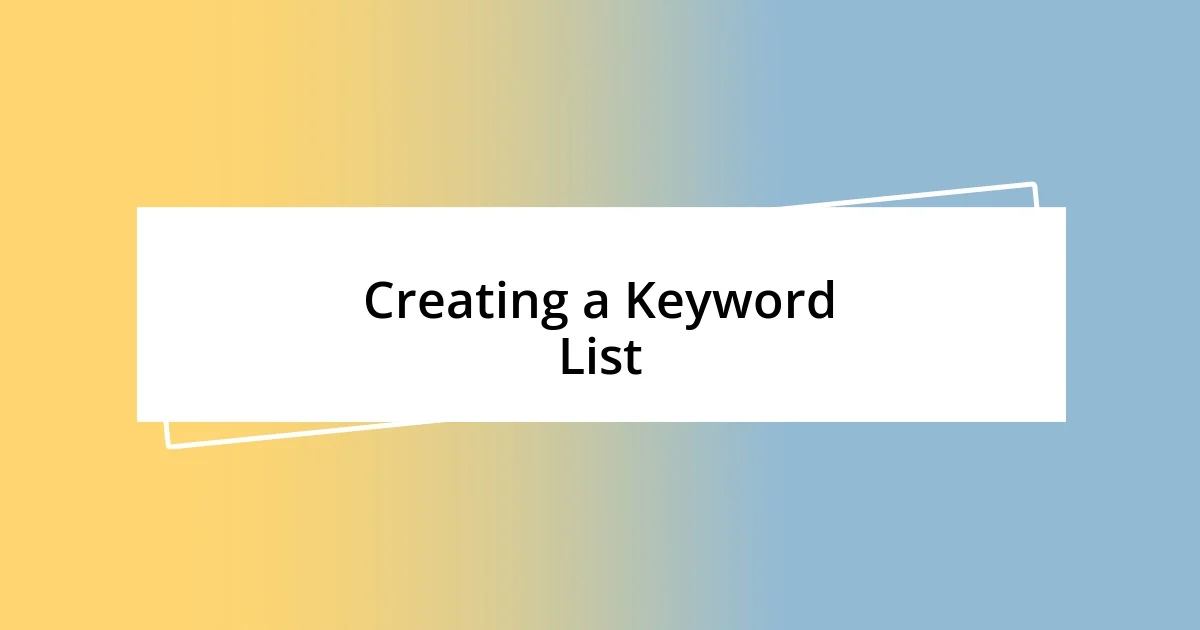Key takeaways:
- Understanding and effectively utilizing keywords can significantly increase audience engagement and content relevance.
- Identifying target audience demographics and needs is crucial to discovering impactful keywords that resonate with readers.
- Regularly refining keywords, including focusing on long-tail phrases and keeping up with trends, can enhance content performance and attract the right audience.

Understanding the Importance of Keywords
Keywords are the backbone of effective digital content; they bridge the gap between what people search for and what we provide. I remember when I first started blogging—picking the right keywords felt like trying to find a needle in a haystack. But when I finally honed in on the terms my audience used, it was like a light bulb went off; my traffic surged, and I realized how powerful the right words can be in reaching the right people.
Think about it: why would someone choose your content over countless options available online? I once wrote an article with keywords that seemed perfect, yet they didn’t resonate with my readers’ actual queries. When I tweaked my strategy, focusing on more specific phrases, my engagement metrics improved dramatically. It’s a reminder of how crucial it is to ensure that our content speaks directly to the needs and searches of our audience.
Incorporating the right keywords feels like having a conversation with your audience. Picture your reader’s journey. What questions are they asking, and how can you help? When I began to view keywords not just as tools but as opportunities to connect with my readers, my content became more relatable and impactful. This shift in mindset transformed not just my writing but also the way my audience interacted with it.

Identifying Your Target Audience
Identifying your target audience is a game changer in keyword research. I vividly recall the struggle I faced early on when I was crafting content without a clear picture of who I was writing for. It felt like I was throwing spaghetti at the wall, hoping something would stick. When I finally took the time to understand my audience’s demographics and interests, everything clicked. Suddenly, the keywords I discovered weren’t just random terms; they were the exact phrases my readers were using in their searches.
To truly identify your target audience, consider these steps:
- Analyze Demographics: Look at age, gender, and location to refine your focus.
- Understand Needs and Pain Points: What challenges do they face? Tailoring your content to solve these issues can drive traffic.
- Dive into Social Media: Platforms like Facebook or LinkedIn can offer great insights into your audience’s preferences and conversations.
- Engage in Community Forums: Places like Reddit or Quora are goldmines for understanding the questions and topics your audience is passionate about.
- Leverage Analytics Tools: Utilize Google Analytics to see what content resonates most with your visitors. Understanding their behavior can guide your keyword choices.
By engaging deeply with who your audience is, you can discover keywords that not only fit but also resonate, leading to more meaningful connections and greater success in your content strategy.

Utilizing Keyword Research Tools
When it comes to utilizing keyword research tools, I’ve found that the right tool can make a significant difference. For instance, I remember experimenting with various platforms early in my writing journey—some left me scratching my head, while others felt like a breath of fresh air. Tools like Google Keyword Planner have become staples for me in uncovering relevant keywords that align with my content goals. Their ability to provide insightful data on search volume and seasonal trends has helped me tailor my content strategy effectively.
Another tool that I absolutely love is SEMrush. It not only allows me to dive deeper into my competitors’ keywords but also reveals potential gaps in my own strategy. In one memorable project, I was stuck for ideas on a niche topic. After analyzing my competitors with SEMrush, I discovered keywords that not only improved my SEO but also sparked fresh content ideas I hadn’t considered before. It’s fascinating how a simple tool can open up new avenues for creativity, isn’t it?
Here’s a quick comparison of some popular keyword research tools I’ve used over the years. Each has its strengths, and your choice may depend on your specific needs.
| Tool | Main Features |
|---|---|
| Google Keyword Planner | Free, great for PPC and SEO, provides search volume data. |
| SEMrush | Competitive analysis, keyword suggestions, and SEO tracking. |
| Ahrefs | Robust backlink analysis, keyword difficulty scores, and content ideas. |
| Ubersuggest | User-friendly, offers keyword suggestions and traffic estimations. |

Analyzing Competitor Keyword Strategies
Analyzing competitor keyword strategies can be incredibly enlightening. I recall a project where I was stuck, unsure which keywords would resonate with my audience. By diving into my competitors’ strategies—using tools like Ahrefs—I discovered they were ranking well for long-tail keywords I hadn’t even considered. These keywords were specific phrases that reflected the very questions my audience had, and incorporating them into my content transformed my SEO performance.
One strategy I often use is examining the top-ranking content in my niche. It’s astonishing how much you can learn just from looking at what others are doing. I remember clicking through to a competitor’s article and taking notes on their keywords, headers, and even the related terms they were using. This not only inspired new content ideas but also helped me understand the context and intent behind those keywords. Have you ever felt that spark of inspiration just from analyzing someone else’s work? It’s like finding a hidden treasure map.
Moreover, I find value in not just the keywords themselves but also in understanding the context surrounding them. What kind of language do competitors use in their articles? How do they engage their audience? By scrutinizing these elements, I’ve been able to adapt my style and enhance my content strategies, bridging the gap between keyword research and genuine reader engagement. It’s a fascinating intersection, isn’t it?

Evaluating Search Intent
Evaluating search intent is a crucial step in keyword research that I often prioritize. Early on, I learned that understanding why users are searching for specific phrases can change the course of my content strategy. For example, during one of my projects, I noticed a spike in searches for “best running shoes for flat feet.” By analyzing the intent, I realized users were seeking detailed reviews rather than generic lists, which helped me tailor my article to provide the depth and specificity those readers craved.
I also love to think about the different types of search intent: informational, navigational, transactional, and local. When I first encountered this framework, it was like a light bulb moment for me. I vividly remember an article I wrote that was meant to be purely informative but ended up attracting a transactional audience instead. The comments section overflowed with requests for product recommendations, leading me to realize that sometimes, the subtleties in keyword intent can unlock unexpected opportunities. Isn’t it interesting how the same keyword can cater to diverse needs?
Moreover, I make it a habit to pose questions to myself while evaluating intent: What do I want my audience to achieve when they find my content? Reflecting on this has improved my ability to provide value in my writing. For instance, when targeting the keyword “home workout routines,” I focused not just on the exercises but also incorporated tips for beginners who might feel intimidating. This dual approach addresses both informational needs and emotional support, ensuring that my audience feels seen and understood. Isn’t that what content creation is really about—building a connection?

Creating a Keyword List
Creating a keyword list is an essential part of my research process, and it often feels like piecing together a puzzle. I start by brainstorming a broad range of keywords related to my niche; sometimes, I even grab a notepad and write down the phrases that pop into my head. Just last week, while sipping my morning coffee, I jotted down terms related to “eco-friendly living” based on recent conversations I had with friends. Seeing them laid out visually truly sparked new ideas for content angles I hadn’t considered before.
Once I have a base list, I turn to tools like Google Keyword Planner and SEMrush to refine my selection. I remember a time when a few keywords I initially thought were too obscure turned out to have decent search volume, and they became the backbone of one of my most successful articles. It’s almost like uncovering hidden gems—each keyword can unlock an opportunity to connect with my audience. Do you ever get that rush of excitement when a keyword resonates with your passions? It’s an incredible feeling.
I also prioritize grouping keywords by topics or themes for better organization. This strategy not only keeps my content focused but also helps me to identify content gaps. For instance, while organizing my keywords for “vegan recipes,” I noticed a disparity: I had plenty of dessert ideas but hardly any savory dishes. From that realization, I created a new series on hearty vegan meals that really filled a void, and seeing the engagement grow was so rewarding. It’s amazing how a simple list can guide the direction of your writing journey, isn’t it?

Refining and Optimizing Keywords
Refining keywords is where the magic often happens. I remember getting too attached to specific keywords, only to find better-performing alternatives through my research. Last month, I was targeting “healthy desserts,” but after some analysis, I switched to “easy healthy dessert recipes.” That small tweak attracted a wider audience seeking quick solutions rather than just the concept of healthy desserts. Have you ever found that a little adjustment can lead to big results?
As I work through my keyword list, I also focus on long-tail keywords. These phrases tend to have less competition and often yield higher conversion rates. For example, after zeroing in on “vegan meal prep,” I started focusing on “easy vegan meal prep for beginners.” This shift not only matched my audience’s needs better but also positioned my content to provide exactly the support they were searching for. It’s fascinating how specific it can get, isn’t it?
Moreover, I frequently revisit and update my keyword strategy. I’ve learned that trends can change rapidly, and staying adaptable is key. Recently, while updating my older content, I discovered that “gluten-free brunch” was trending in search engines. Incorporating this insight allowed me to refresh an outdated post, and I watched the traffic increase almost immediately. Have you ever revisited your old content and found hidden opportunities just waiting to be uncovered?












